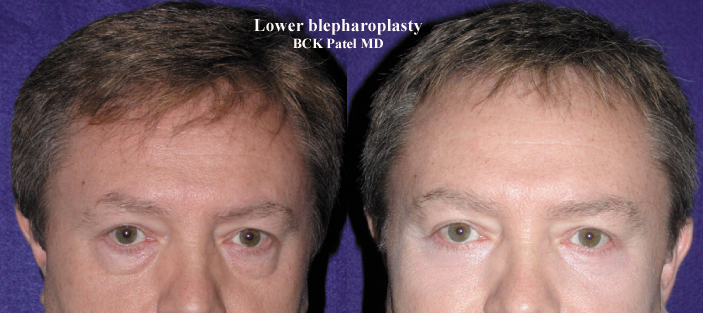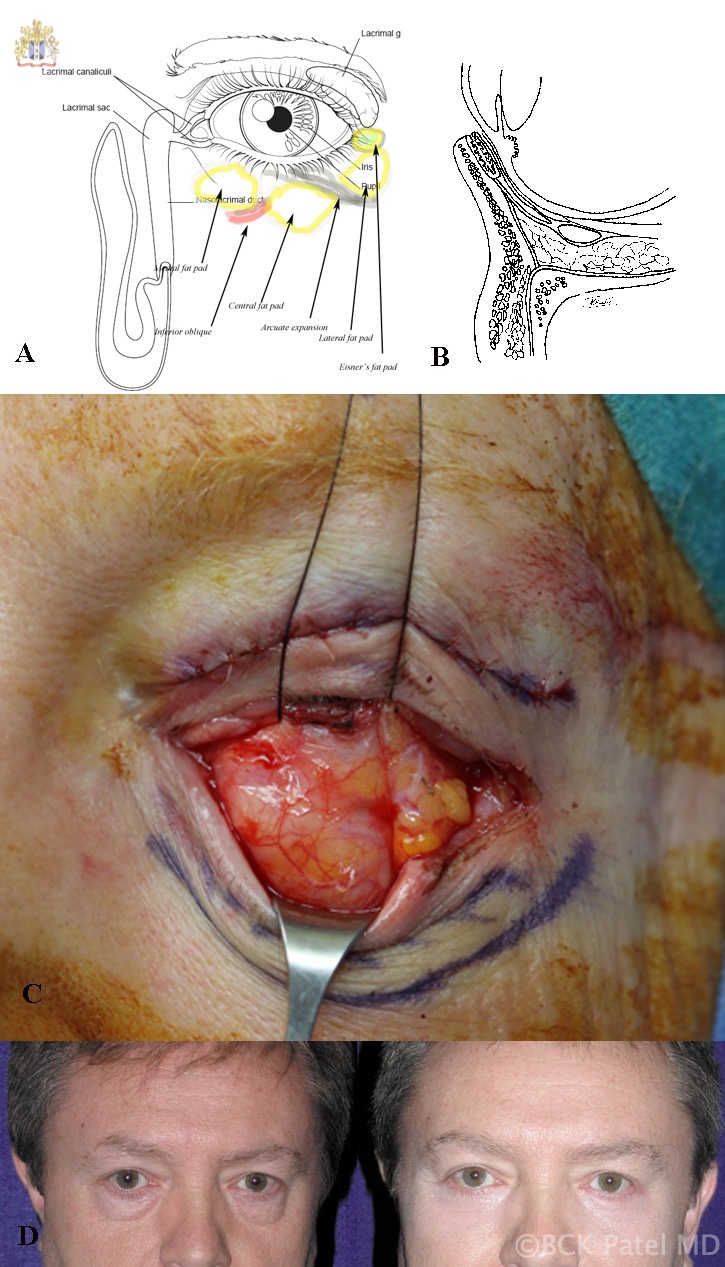[1]
Davison SP, Iorio ML, Oh C. Transconjunctival lower lid blepharoplasty with and without fat repositioning. Clinics in plastic surgery. 2015 Jan:42(1):51-6. doi: 10.1016/j.cps.2014.09.001. Epub
[PubMed PMID: 25440740]
[2]
Kashkouli MB, Pakdel F, Kiavash V, Ghiasian L, Heirati A, Jamshidian-Tehrani M. Transconjunctival lower blepharoplasty: a 2-sided assessment of results and subjects' satisfaction. Ophthalmic plastic and reconstructive surgery. 2013 Jul-Aug:29(4):249-55. doi: 10.1097/IOP.0b013e31828ecfb9. Epub
[PubMed PMID: 23645352]
[3]
Murri M, Hamill EB, Hauck MJ, Marx DP. An Update on Lower Lid Blepharoplasty. Seminars in plastic surgery. 2017 Feb:31(1):46-50. doi: 10.1055/s-0037-1598632. Epub
[PubMed PMID: 28255289]
[4]
Hwang K. Surgical anatomy of the lower eyelid relating to lower blepharoplasty. Anatomy & cell biology. 2010 Mar:43(1):15-24. doi: 10.5115/acb.2010.43.1.15. Epub 2010 Mar 31
[PubMed PMID: 21190001]
[5]
Hashem AM, Couto RA, Waltzman JT, Drake RL, Zins JE. Evidence-Based Medicine: A Graded Approach to Lower Lid Blepharoplasty. Plastic and reconstructive surgery. 2017 Jan:139(1):139e-150e. doi: 10.1097/PRS.0000000000002849. Epub
[PubMed PMID: 28027251]
[6]
Pacella SJ, Nahai FR, Nahai F. Transconjunctival blepharoplasty for upper and lower eyelids. Plastic and reconstructive surgery. 2010 Jan:125(1):384-392. doi: 10.1097/PRS.0b013e3181c2a534. Epub
[PubMed PMID: 20048630]
[7]
Collar RM, Lyford-Pike S, Byrne P. Algorithmic approach to lower lid blepharoplasty. Facial plastic surgery : FPS. 2013 Feb:29(1):32-9. doi: 10.1055/s-0033-1333836. Epub 2013 Feb 20
[PubMed PMID: 23426750]
[8]
Jelks GW, Jelks EB. Preoperative evaluation of the blepharoplasty patient. Bypassing the pitfalls. Clinics in plastic surgery. 1993 Apr:20(2):213-23; discussion 224
[PubMed PMID: 8485931]
[9]
Jelks GW, Jelks EB. The influence of orbital and eyelid anatomy on the palpebral aperture. Clinics in plastic surgery. 1991 Jan:18(1):183-95
[PubMed PMID: 2015744]
[10]
Gausas RE. Advances in applied anatomy of the eyelid and orbit. Current opinion in ophthalmology. 2004 Oct:15(5):422-5
[PubMed PMID: 15625904]
Level 3 (low-level) evidence
[11]
Hidalgo DA. An integrated approach to lower blepharoplasty. Plastic and reconstructive surgery. 2011 Jan:127(1):386-395. doi: 10.1097/PRS.0b013e3181f95c66. Epub
[PubMed PMID: 21200234]
[12]
de Castro CC. A critical analysis of the current surgical concepts for lower blepharoplasty. Plastic and reconstructive surgery. 2004 Sep 1:114(3):785-93; discussion 794-6
[PubMed PMID: 15318063]
[13]
Rizk SS, Matarasso A. Lower eyelid blepharoplasty: analysis of indications and the treatment of 100 patients. Plastic and reconstructive surgery. 2003 Mar:111(3):1299-306; discussion 1307-8
[PubMed PMID: 12621205]
[14]
Naik MN, Honavar SG, Das S, Desai S, Dhepe N. Blepharoplasty: an overview. Journal of cutaneous and aesthetic surgery. 2009 Jan:2(1):6-11. doi: 10.4103/0974-2077.53092. Epub
[PubMed PMID: 20300364]
Level 3 (low-level) evidence
[15]
Drolet BC, Sullivan PK. Evidence-based medicine: Blepharoplasty. Plastic and reconstructive surgery. 2014 May:133(5):1195-1205. doi: 10.1097/PRS.0000000000000087. Epub
[PubMed PMID: 24776550]
[16]
Jindal K, Sarcia M, Codner MA. Functional considerations in aesthetic eyelid surgery. Plastic and reconstructive surgery. 2014 Dec:134(6):1154-1170. doi: 10.1097/PRS.0000000000000748. Epub
[PubMed PMID: 25415085]
[17]
Becker DG, Tardy ME Jr. Standardized photography in facial plastic surgery: pearls and pitfalls. Facial plastic surgery : FPS. 1999:15(2):93-9
[PubMed PMID: 11816129]
[18]
Nassif PS. Lower blepharoplasty: transconjunctival fat repositioning. Facial plastic surgery clinics of North America. 2005 Nov:13(4):553-9, vi
[PubMed PMID: 16253842]
[19]
Branham GH. Lower Eyelid Blepharoplasty. Facial plastic surgery clinics of North America. 2016 May:24(2):129-38. doi: 10.1016/j.fsc.2015.12.004. Epub
[PubMed PMID: 27105798]
[20]
Pack S, Quereshy FA, Altay MA, Baur DA. Transconjunctival Lower Blepharoplasty. Atlas of the oral and maxillofacial surgery clinics of North America. 2016 Sep:24(2):147-51. doi: 10.1016/j.cxom.2016.05.011. Epub 2016 Jun 23
[PubMed PMID: 27499473]
[21]
Schwarcz R, Fezza JP, Jacono A, Massry GG. Stop Blaming the Septum. Ophthalmic plastic and reconstructive surgery. 2016 Jan-Feb:32(1):49-52. doi: 10.1097/IOP.0000000000000420. Epub
[PubMed PMID: 25719376]
[22]
Yoo DB, Peng GL, Massry GG. Transconjunctival lower blepharoplasty with fat repositioning: a retrospective comparison of transposing fat to the subperiosteal vs supraperiosteal planes. JAMA facial plastic surgery. 2013 May:15(3):176-81. doi: 10.1001/jamafacial.2013.749. Epub
[PubMed PMID: 23471339]
Level 2 (mid-level) evidence
[23]
Perkins SW, Dyer WK 2nd, Simo F. Transconjunctival approach to lower eyelid blepharoplasty. Experience, indications, and technique in 300 patients. Archives of otolaryngology--head & neck surgery. 1994 Feb:120(2):172-7
[PubMed PMID: 8297575]
[24]
Kim EM, Bucky LP. Power of the pinch: pinch lower lid blepharoplasty. Annals of plastic surgery. 2008 May:60(5):532-7. doi: 10.1097/SAP.0b013e318172f60e. Epub
[PubMed PMID: 18434828]
[25]
Einan-Lifshitz A, Holds JB, Wulc AE, Hartstein ME. Volumetric rejuvenation of the tear trough with repo and Ristow. Ophthalmic plastic and reconstructive surgery. 2013 Nov-Dec:29(6):481-5. doi: 10.1097/IOP.0b013e3182a23270. Epub
[PubMed PMID: 24217478]
[26]
Lelli GJ Jr, Lisman RD. Blepharoplasty complications. Plastic and reconstructive surgery. 2010 Mar:125(3):1007-17. doi: 10.1097/PRS.0b013e3181ce17e8. Epub
[PubMed PMID: 20195127]
[27]
Mack WP. Blepharoplasty complications. Facial plastic surgery : FPS. 2012 Jun:28(3):273-87. doi: 10.1055/s-0032-1312705. Epub 2012 Jun 21
[PubMed PMID: 22723228]
[28]
Pacella SJ, Codner MA. Minor complications after blepharoplasty: dry eyes, chemosis, granulomas, ptosis, and scleral show. Plastic and reconstructive surgery. 2010 Feb:125(2):709-718. doi: 10.1097/PRS.0b013e3181c830c7. Epub
[PubMed PMID: 20124856]


